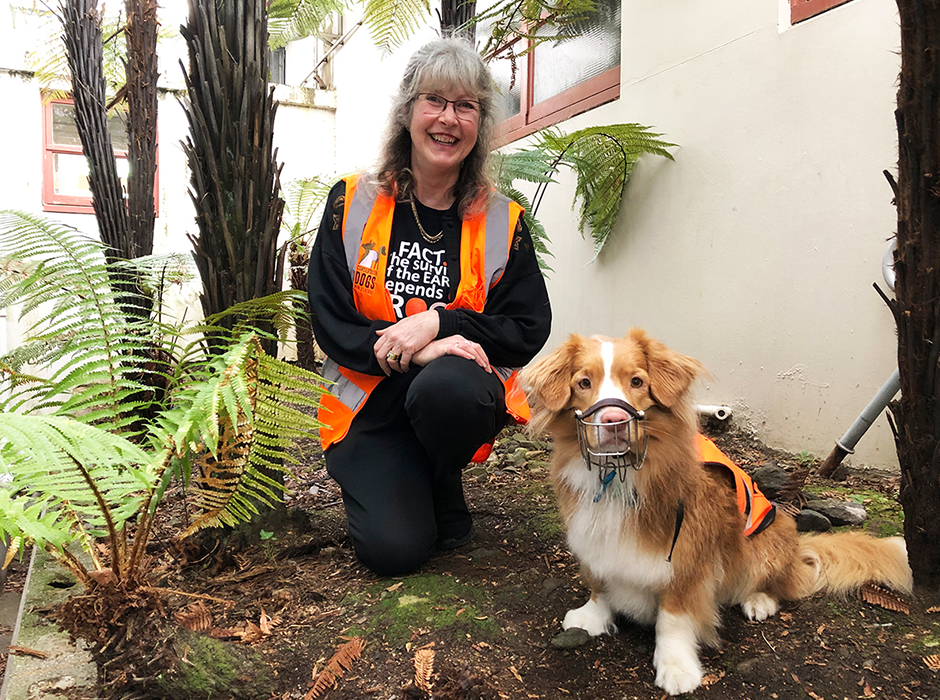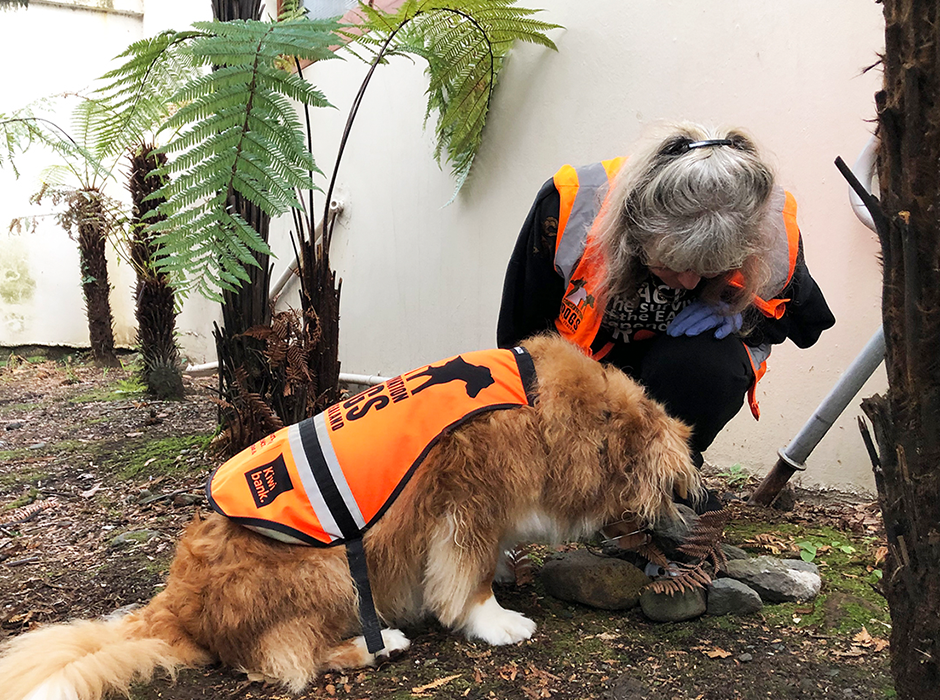
Debbie Bishop with Holly, a Nova Scotia Duck Tolling Retriever, who recently became New Zealand’s first native frog-certified dog from the Department of Conservation’s Conservation Dogs Programme.
As the smallest of the litter and weighing 1.25kg, Holly, a Nova Scotia Duck Tolling Retriever was born on 17 Feb 2018. Recently, she became New Zealand’s first native frog-certified dog from the Department of Conservation’s (DOC) Conservation Dogs Programme.
More accurately, it’s the team of Holly and her owner Debbie Bishop who have together received the DOC accreditation as dog and handler, an accomplishment which realises the vision of her late husband and Zoology frog researcher Emeritus Professor Phil Bishop.
It’s been a long and demanding and project, but Debbie is elated to have seen Professor Bishop’s vision for the role of conservation dogs in his field of research through to fruition.
Professor Bishop’s work with Aotearoa New Zealand’s endangered native Leiopelma frogs had highlighted the challenges of their monitoring due to low numbers, patchy distributions and preferred habitats.
“After going on a trip with DOC to Fiordland, Phil was convinced that native frogs may still exist there, and that one day using dogs we could go and explore relevant sites where native frogs roamed many years ago,” Debbie explains. “Phil had been interested in the contribution that conservation dogs could make to such a degree that we began training Holly.”
They were both proud of the interim certification that Holly received in late 2019, and in the following year Debbie and Phil experienced a moment of shared pride when she found her first native Archey’s frog in the wild at Mahakirau Forest Estate in the Coromandel.
In the time since, while coming to terms with life following Phil’s death as well as the pandemic, Debbie forged ahead with the aspirational goal and embarked on the more intensive part of the training process for certification.
Much of the training was conducted at the Department of Zoology where Debbie and Holly could access the native frogs kept in captivity including Archey’s frog, New Zealand’s smallest native frog which is globally critically endangered.
Debbie and Holly were provided with a dedicated room in Zoology for training which involved, for example, using planks with holes under which frogs in containers could be moved around. Rock piles, concrete blocks and scattered leaf litter were also used to more closely simulate wild conditions.
Holly’s full certification tests by DOC were also undertaken at the Zoology Department and in the local environment using the native frogs as subjects. The ultimate purpose for Holly’s certification is to help improve non-invasive population monitoring and surveying for native species of frog, ultimately informing effective species conservation management plans.

Debbie used spaces within the Department of Zoology to train Holly to detect Aotearoa New Zealand’s endangered native Leiopelma frogs.
Debbie says that having the access to the space and frogs in Zoology was just incredible and that staff and students were so accommodating and understanding when Holly was in training mode.
“I wouldn’t have been able to get here without the support of the Zoology department which I’m so grateful for. I really want to say a huge thank you as everyone has been incredibly mindful of Holly and I being there and allowed us to just get on doing what we were there to do.”
Speaking on behalf of the Department of Zoology, Head of Department Associate Professor Mark Lokman says he’s delighted about the new opportunities for the conservation of New Zealand native frogs that come with Holly’s certification.
“I am especially thrilled for Debbie to have achieved this milestone – her grit, determination and resilience have allowed not only for Holly’s success, but have also enabled one of Phil’s graduate students Tegan Murrell to complete her master’s research,” Associate Professor Lokman says. “Debbie’s commitment and enthusiasm are exemplary and inspirational.”
Debbie is now looking forward to an exciting future with Holly, to assist with the conservation of native frog species. The season for tracking frogs spans from spring to autumn (excluding the height of summer due to hatching), as during winter the frogs maybe up to 30cm underground.
While Holly is New Zealand’s first native frog-dog, she is also providing another valuable wellbeing service to the community by being registered as a Pet Therapy dog through Hato Hone St John, a way of giving back to the community for all the support they give to the community and to families in their time of need.
As a working pet and an important member of the household, Holly was a big part of the final years that Debbie shared with Phil. “Holly is an intelligent and amazing companion and I don’t know how I would have survived without her by my side,” Debbie reflects.
“Phil would’ve been excited, ecstatic and be absolutely thrilled if he could see what Holly and I have achieved, and even though he would have loved to be out in the field finding native frogs with Holly, it’s really comforting knowing she is now capable of realising the vision he had from the start.”
Acknowledgements:
Debbie would also like to say thank you to those from the Department of Conservation (Helen Neale, James Fraser, Max Smart and Hannah Irwin), Mahakirau Forest Estate (Jane Hooson and Sara Smerdon), Auckland Zoo (Richard Gibson) and Phoenix SPB Ltd (Billy Barton) for their unwavering guidance, encouragement and support over the years during Holly’s training for accreditation.
Kōrero by Guy Frederick, Sciences Communications Adviser
